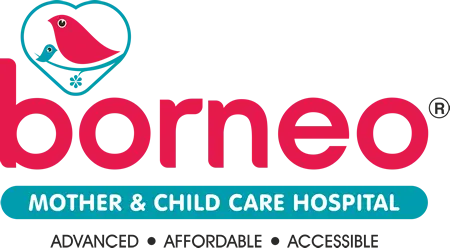As parents, our children’s health is our utmost priority. So, when your little one develops a cough, a fever, or just isn’t their usual energetic self, it’s natural to feel a surge of concern. “Is this serious?” “Should I call the doctor?” These are questions every parent grapples with. Childhood illnesses are, unfortunately, a common part of growing up, but knowing how to recognise symptoms and when to seek professional help can make all the difference.
I’m Dr. Santosh Madrewar, Senior Paediatrician and Founder of Borneo Hospital. With our dedicated paediatric departments across Thane, Nashik, Chhatrapati Sambhaji Nagar, and Raipur City, my team and I are committed to supporting families through these common childhood health challenges. Our goal is to empower you with the knowledge to care confidently for your child at home when appropriate, and to act decisively when professional medical attention is needed.
This article aims to provide a practical guide to some of the most common Pediatric Illnesses, helping you understand their typical symptoms, learn about safe and supportive home care, and crucially, identify those important “red flag” signs that mean it’s time to consult a paediatrician at Borneo Hospital or seek urgent medical care.
Understanding Childhood Illnesses: A Parent’s Perspective
It often seems like young children catch one thing after another! This is largely because their immune systems are still developing and learning to fight off the multitude of viruses and bacteria they encounter, especially once they start interacting with other children at playgroups, daycare, or school.
As a parent, you know your child best. You’re often the first to notice when they’re “not quite themselves.” Trusting your instincts is very important. While many common childhood ailments are mild and self-limiting, it’s essential to strike a balance between watchful waiting for minor symptoms and seeking timely medical advice when concerns arise.
Common Pediatric Illnesses: Symptoms, Home Care, and Red Flags
Let’s explore some frequent Pediatric Illnesses:
1. The Common Cold (Upper Respiratory Infection)
Description:
A viral infection primarily affecting the nose and throat. Colds are very common, and young children can have many in a year!
Common Symptoms:
Runny or stuffy nose (discharge often starts clear and may thicken or turn yellowish/greenish over a few days), sore throat, mild cough, sneezing, sometimes a mild fever (usually low-grade).
Supportive Home Care:
There’s no cure for the common cold (antibiotics don’t work on viruses!), but you can help your child feel more comfortable:
Rest:
Encourage quiet play and ensure they get enough sleep.
Fluids:
Offer plenty of fluids like water, warm clear soups, or breastmilk/formula for infants to prevent dehydration and soothe a sore throat.
Nasal Congestion:
Saline nasal drops or spray (available from your chemist) can help clear a stuffy nose, especially before feeds and sleep. A cool-mist humidifier in the room (ensure it’s cleaned regularly) can also ease congestion.
Sore Throat/Cough:
For children over one year old, a little honey (about half to one teaspoon) can help soothe a cough and sore throat. Avoid cough and cold medicines in young children unless specifically advised by your paediatrician.

When to See a Paediatrician at Borneo Hospital:
- High fever (see Fever section for specifics).
- Difficulty breathing, rapid breathing, or wheezing.
- A persistent cough lasting more than two to three weeks, or a cough that gets significantly worse.
- Signs of an ear infection (pulling at ears, ear pain).
- Refusing to drink fluids or showing signs of dehydration.
- Unusual sleepiness, lethargy, or being much less active than usual.
2. Fever (Pyrexia)
- Description: Fever is an elevated body temperature. It’s important to remember that fever itself is not an illness but a common symptom – usually the body’s natural response to an infection.
- Common Symptoms: A temperature above 100.4°F (38°C) taken rectally (most accurate for infants), orally, or by ear is generally considered a fever. Your child might also be irritable, flushed, sweaty, lethargic, have a poor appetite, or show other signs of the underlying illness.
- Supportive Home Care: The main aim is to make your child comfortable.
- Dress Lightly: Avoid overdressing or using heavy blankets.
- Cool Environment: Keep the room comfortably cool.
- Fluids: Offer plenty of fluids to prevent dehydration.
- Lukewarm Sponging: If your child is distressed by the fever, a lukewarm (not cold) sponge bath for 5-10 minutes may help bring the temperature down slightly and provide comfort. Avoid cold water or alcohol rubs.
- Fever-Reducing Medication: Paracetamol or ibuprofen can be used to lower fever and relieve discomfort. CRITICAL: Always use these medications strictly according to your paediatrician’s specific dosage advice based on your child’s current age and weight. Never give aspirin to children or teenagers due to the risk of Reye’s syndrome.
- When to See a Paediatrician (RED FLAGS FOR FEVER):
- Any fever in an infant under 3 months old requires IMMEDIATE medical attention.
- High fever (e.g., over 102-103°F or 39-39.5°C) that doesn’t come down with appropriate fever-reducing medication.
- Fever lasting more than 3-5 days, even if not very high.
- Fever accompanied by other worrying symptoms such as: a stiff neck, severe headache, persistent vomiting, difficulty breathing, a rash (especially one that doesn’t fade when pressed with a glass), convulsions (fits/seizures), extreme irritability or unresponsiveness, signs of dehydration.
3. Cough & Sore Throat
- Description: Coughs can be caused by viral infections (like colds or flu), allergies, asthma, or sometimes bacterial infections. Sore throats often accompany colds or can be due to infections like strep throat (more common in older children).
- Symptoms: Coughs vary – dry and tickly, chesty and phlegmy, or a harsh, barking cough (characteristic of croup). Sore throat typically involves pain, scratchiness, or difficulty swallowing.
- Supportive Home Care (for mild viral symptoms):
- Fluids: Warm clear fluids (like warm water with a little honey and lemon for older children – honey only for children over 1 year) can be soothing.
- Steam/Humidity: Inhaling steam (e.g., from a steamy bathroom, or using a cool-mist humidifier) can ease a dry cough or croup. Use caution with hot steam for older children only.
- Rest: Allow plenty of rest.
- When to See a Paediatrician:
- Difficulty breathing, rapid breathing, wheezing, or stridor (a harsh, high-pitched noise when your child breathes in).
- Bluish tinge around the lips, face, or fingernails.
- Inability to swallow saliva (excessive drooling).
- Severe throat pain that makes it difficult to drink.
- Persistent high fever alongside the cough/sore throat.
- A cough that lasts for several weeks, significantly worsens, or is associated with significant chest pain.
- Suspected whooping cough (pertussis – bouts of severe coughing, often with a ‘whoop’ sound).
4.Diarrhoea & Vomiting (Gastroenteritis / “Stomach Flu”)
- Description: Often caused by viral infections affecting the digestive system, but can sometimes be bacterial or parasitic. Highly contagious.
- Symptoms: Frequent loose or watery stools (diarrhoea), vomiting, abdominal cramps or pain, sometimes a mild fever.
- Supportive Home Care (Crucial for Mild Cases with NO Dehydration):
- Oral Rehydration Solution (ORS) is VITAL: This is the most important treatment to prevent dehydration. ORS powders (available at any chemist in India) should be mixed exactly as per instructions and offered in frequent, small sips, especially after each loose stool or vomit.
- Continue Feeding: For infants, continue breastfeeding or formula feeding alongside ORS. Breast milk is easily digested and helps with recovery. For older children, once vomiting settles, gradually reintroduce their normal diet, starting with bland, easily digestible foods like plain rice, dal-rice, curd-rice, bananas, idli, or toast. Avoid sugary drinks, undiluted fruit juices, or very rich/fatty foods initially.
- When to See a Paediatrician (RED FLAGS FOR DIARRHOEA/VOMITING):
- Signs of Dehydration: This is the biggest concern. Look for: dry mouth or tongue, few or no tears when crying, sunken eyes, a sunken fontanelle (the soft spot on a baby’s head), significantly reduced urination (e.g., fewer than 4 wet nappies in 24 hours for an infant, or no urine for 6-8 hours in an older child), unusual sleepiness, lack of energy, or dizziness.
- Blood or mucus in the stool.
- Persistent high fever.
- Severe or worsening abdominal pain.
- Persistent vomiting that prevents keeping any fluids down, even small sips of ORS.
- Greenish (bile-stained) vomit.
5. Common Skin Rashes (Brief Overview):
- Description: Children get many types of rashes – heat rash (‘prickly heat’), nappy rash, viral rashes (like roseola, chickenpox, hand-foot-and-mouth disease), eczema flare-ups, insect bites.
- Supportive Home Care (for mild, non-concerning rashes): Keep the skin clean and dry. For heat rash, loose cotton clothing and a cool environment help. For nappy rash, frequent nappy changes, gentle cleaning, air exposure, and barrier creams (like zinc oxide) are effective. For mild eczema, regular use of emollients (moisturisers).
- When to See a Paediatrician:
- Any rash accompanied by a high fever or if the child seems generally unwell or very irritable.
- A widespread blistering rash.
- A rash that looks like small bruises or tiny purple/red spots that do not fade when you press a glass firmly against them (non-blanching purpura or petechiae) – THIS IS A MEDICAL EMERGENCY and could indicate a serious infection like meningitis.
- Signs of skin infection developing in a rash (spreading redness, warmth, swelling, pain, pus discharge).
6. Ear Infections (Otitis Media):
- Description: An infection of the middle ear (the space behind the eardrum), often following a cold. Very common in young children.
- Symptoms: Ear pain (infants and toddlers might pull, tug, or rub their ears), fever, irritability (especially when lying down), difficulty sleeping, sometimes fluid discharge from the ear (if the eardrum perforates).
- Supportive Home Care: Pain relief with paracetamol or ibuprofen (follow your doctor’s dosage advice).
- When to See a Paediatrician: A suspected ear infection usually warrants a doctor’s visit for accurate diagnosis, as bacterial infections may need antibiotic treatment. See your doctor for severe ear pain, high fever, discharge from the ear, or if hearing seems affected.
General “When to Worry” Guidelines (Overarching Red Flags)
Beyond specific illnesses, certain general signs in a child should always prompt you to seek urgent medical attention:
- Extreme Lethargy or Unresponsiveness: Your child is unusually sleepy, very difficult to wake, seems floppy or limp, or isn’t interacting with you.
- Difficulty Breathing: Working hard to breathe (you might see their nostrils flaring, the skin pulling in around their ribs or neck), breathing very fast, making grunting or noisy sounds when breathing, or having a bluish tinge around their lips or face.
- Signs of Dehydration (as listed under Diarrhoea & Vomiting).
- High, Persistent Fever, especially if your child is under 3 months old or the fever doesn’t respond to appropriate medication.
- Seizures / Convulsions / Fits.
- A Non-Blanching Rash (a rash that looks like bruises or tiny red/purple spots that don’t disappear when you press a glass against them).
- Severe or Localised Pain that doesn’t improve or seems out of proportion to the situation.
- Your Parental Instinct: As a parent, you know your child best. If you are very worried that something is seriously wrong, even if the symptoms don’t perfectly match a list, it is always okay to seek medical advice. Trust your gut feeling.

The Importance of a Trusted Paediatrician
Having a regular, trusted Paediatrician is invaluable. At Borneo Hospital, our paediatric team, including myself, gets to know your child’s health history, their normal behaviour, and their growth patterns. This continuity of care allows for:
- More accurate diagnosis and management of illnesses.
- Tracking of growth and development.
- Ensuring timely immunisations.
- Building a supportive partnership where you feel comfortable asking questions and discussing any concerns about your child’s health. Your paediatrician can often provide advice over the phone for milder conditions or guide you on whether an urgent visit or trip to the emergency department is necessary.
Simple Preventive Measures
While you can’t prevent all Pediatric Illnesses, these steps help:
Handwashing:
Teach and practice frequent, thorough handwashing with soap and water for everyone in the family.
Vaccinations:
Ensuring your child’s immunisations are up-to-date according to the recommended schedule is the single most effective way to protect them against many serious infectious diseases.
Healthy Lifestyle:
A balanced diet and adequate sleep support a robust immune system.
Avoid Sick Contacts:
Where practical, try to limit your child’s close contact with individuals who are clearly unwell with contagious illnesses.
Childhood is filled with growth, learning, and unfortunately, occasional Pediatric Illnesses. While many common ailments are mild and can be managed with supportive care at home, it’s crucial for parents to be aware of the symptoms and, most importantly, to recognise those “red flag” signs that indicate a more serious condition requiring prompt medical attention from a paediatrician.
Understanding these basics can empower you to care for your child confidently, provide comfort when they are unwell, and make informed decisions about when to seek expert help from the team at Borneo Hospital. Remember, we are your partners in ensuring your child’s health and well-being across our branches in Thane, Nashik, Chhatrapati Sambhaji Nagar, and Raipur City. Never hesitate to reach out if you are worried.


